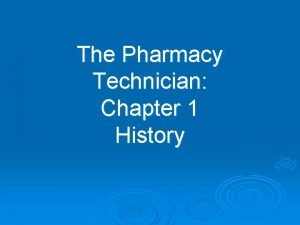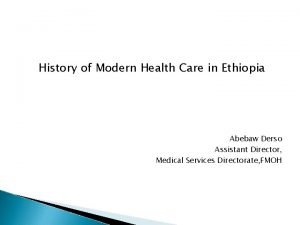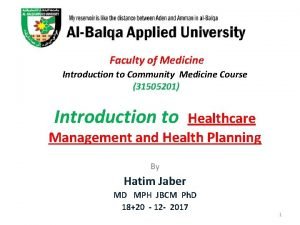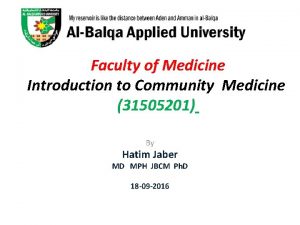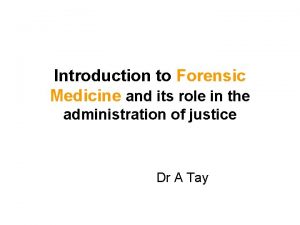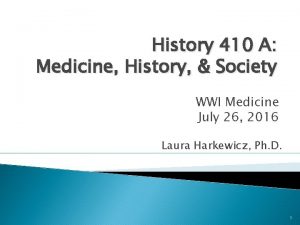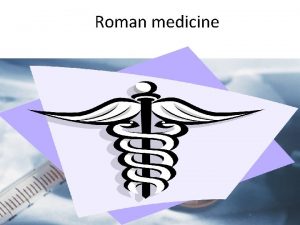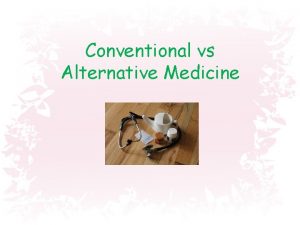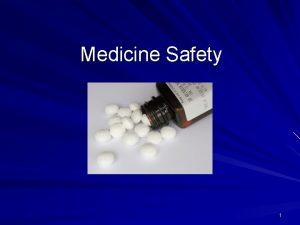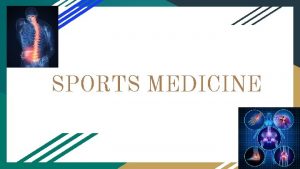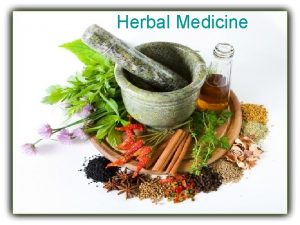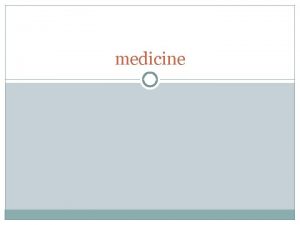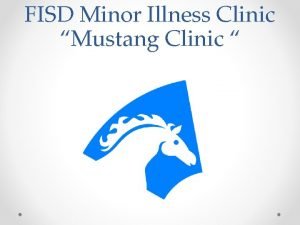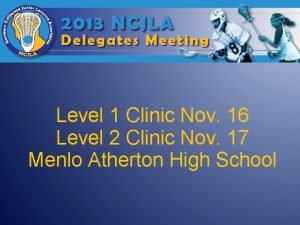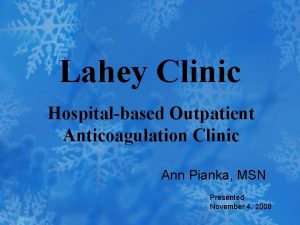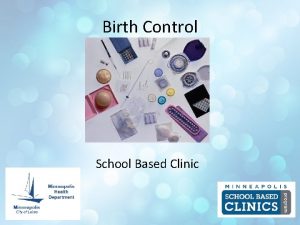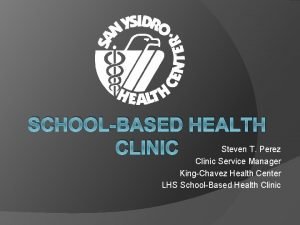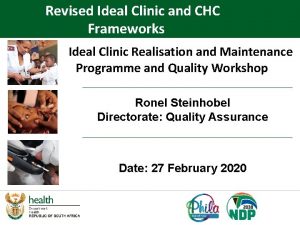Introduction to medicine History of the Kornyi Clinic























- Slides: 23

Introduction to medicine. History of the Korányi Clinic Dr. Szathmári Miklós Semmelweis University First Department of Medicine 12. Sept. 2011.

The science and the art of medicine The knowledge gained from the science of medicine has improved and will further improve our understanding of complex disease processes and provide new approaches to disease treatment and prevention. Yet skill in the most sophisticated application of laboratory technology and the use of the latest therapeutic modality alone does not make a good physician.

The science and the art of medicine An effective physician must be able to identify the crucial elements in a complex history and physical examination, to order the appropriate laboratory tests, to extract the key results from the crowded printouts of data to determine whether to „treat” or to „watch”, and weighing whether a proposed treatment entails a greater risk than the disease itself. These are essential judgments that the skilled clinician must make many times each day. This combination of medical knowledge, intuition, experience, and judgment defines the art of medicine, which is as necessary to the practice of medicine as is a sound scientific base.

The original term of internal medicine • Traditionally „internal medicine” was defined as a medical specialty devoted to the comprehensive care of adult patients, focusing on the diagnosis and nonsurgical treatment of diseases affecting internal organs and systems. • According to William Osler’s idea the „internal” in internal medicine does not refer to the interior of the body, but rather refers to a physician who gets to the inside of a clinical problem by using knowledge that comes from experimental science. In other words, internal medicine means getting to the underlying basis of the signs and symptoms of an illness, using the experimental method rather than dogma.

Using experimental methods to get to the insight of a clinical problem, and translate it in the treatment of patients – As a Professor in Internal Medicine in 1907, he had only a small clinic with two wards, but had a laboratory in which his groundbreaking scientific studies were performed – Applying cryoscopy, he established that the adaptation of freezing point depression of urine in nephritic patients is limited. – He introduced the term „renal insufficiency (1896) – He proposed that the diet should be tailored to the capacity of the kidney.

Consequences of the explosion in scientific knowledge • The division of knowledge originated subspecialties. These may be grouped according to – the organs or systems of interest (cardiology, gastroenterology, etc) – pathogenic mechanism (clinical immunology, infectious diseases, etc) – characteristics of the patients (intensive medicine, geriatrics, etc), – and some are mainly devoted to diagnostic or therapeutic procedures (radiology, isotope therapy, etc)

Consequences of the explosion in scientific knowledge • The hospital environment has transformed dramatically over the past few decades. Hospitals now consist of multiple distinct levels of care, such as the emergency department, critical care unit, procedure room, etc. in addition to traditional medical wards. • There is an increasing pressure to manage complex disorders in the outpatient setting. • These system may threaten the traditional one-to-one relationship between patient and physician, and undermine the trust relationship between patient and physician

Important challenges in internal medicine • Holistic medicine versus patient’s care by subspecialists. To treat the whole person rather than just the symptoms • „Hand-offs” system vs one-to-one relationship between physician and patient. To maintain the continuity of care and information flow • Evidence based medicine and use of guidelines vs. subjective judgments. Physicians are expected to master rapidly advancing fields (the science of medicine) while considering their patient’s unique needs (the art of medicine)

Important challenges in internal medicine • Continuously improving diagnostic methods and treatment modalities – continuously decreasing patient’s satisfaction. It is the duty of the patient’s principal or primary physician to provide cohesive guidance through an illness.

What does it mean today to be an internist • The good internist is knowledgable about all aspects of internal medicine, • has an ability to diagnose an acute or chronic medical problem, • Has a primary commitment to his/her patients. • Making a lot of money is not a concern of such an internist, and they are not jealous of doctors in other specialties who often become relatively wealthy • They take pleasure in acknowledging the fact that they could not practice good internal medicine without outstanding support from radiologist, pathologist, medical subspecialists, and surgeons. • Theirs is a lifetime of study • They communicate effectively and promptly with their patients and thereby relieve anxiety.

Historical review of the development of medicine • • 12. century – The beginning of secular medicine 13 -16. centuries – The start of the pharamaceutical therapy 17 - 18. centuries: – The knowledge of the human body structure 1750 -1850: – The description of symptoms of disease – Development of physical diagnostic 1850 -1900: – Pathogenic way of thinking – The start of pharmaceutical industries 1900 -1950: – Pathophysiological way of thinking – The development of biochemical diagnostic methods 1950 -2000: – New possibilities in pharmaceutical therapy – Modern imaging techniques – Development of the immunology – Start of the genomic era 2003 – complete sequencing of the human genome

The uroscope the symbol of medicine in Middle Ages


Historical review of the development of internal medicine • Hermann Boerhaave (1668 -1738): Firstly applied bedside-teaching. • Gerard van Swieten (1700 -1772): Introduced doctor’s training in the hospital in the Habsburg Empire • De Haen Anton (1704 -1776) Introduced the use of medical record. • Augenbrugger Leopold (1722 -1809): Introduced the method of percussion • Laënnec René, Theophyile Hyacinthe (1781 -1826): constructed the first stethoscop. • Skoda Jozeph (1805 -1881) Introduced the term internal medicine

Historical review of the development of medicine – Laying the foundation of clinical hematology (1845, Virchow(1821 -1902) – Immunotherapy Behring (Nobel-price) – Domagk Gerhard (1895 -1964) Discovery of antibacterial effect of sulphonamids. Nobel-prize. – The begininng of clinical use of blood pressure measurement (Riva. Rocci 1896) – Discovery of X-ray (1892) – Discovery of electrocardiography (1902, Einthoven) – First coronary catheterization (1929), Forrsmann Werner 1904 -1979 Nobel-prize) – The introduction of percutaneous coronary angioplasty (1977 Andreas Gruntzig) – The development of endocrinology • Kocher Theodor, 1841 -1917, Surgery of goiter, thyroid gland physilology (Nobel-prize) • The discovery of insulin (Banting, Macleod, Best, 1921 -Nobel-prize), • Cushing Harvey (1869 -1939) – …….

The role of internal medicine in the education of medical doctors § The medical students have to attain: • the elements of comprehensive physical examination • medical thinking • the ability to solve medical problems • making decision § To learn these abilities experience with a broad spectrum of disorders and sufferings are needed that are present only on a department of general internal medicine.

Jendrassik Ernő (1858 -1921) Pathogenic way of thinking: - Study of reflexes - The use of modern antifebrile methods - The use of kalomel as diuretic drug - Description of neurological complications of syphilis - Explanation the importance of heritable features in some disorders

Korányi Sándor (1866 -1944) 1889 - He obtained his medical diploma 1900 - He was made honorary professor of neurology 1907 – professor of internal medicine 1909 -1921 – Head of the 3 rd Department of Medicine 1921 -1936. Head of the 1 st Department of Medicine Scientific activities: • He laid the foundation of modern nephrology • Pathogenesis of arrhythmias • Relationship of high blood pressure to cardiac disturbences • Digitalis therapy in heart disease • Concept of cytostatic treatment in malignant hematological diseases

Herzog Ferenc (1879 -1952) • 1902 - graduated • 1914 – Professor of Internal Medicine • Head of the 1 st Dep. of Med. : 1936 -1946 • He introduced the use of ECG in Hungary • Other fields of his scientific activity: hypertension, heart failure, hypophysis tumors.

Heads of 1 st Dep. of Medicine, Semmelweis University between 1946 -2007 Rusznyák István (1889 -1974) Head of the Dep: : 1946 -1962 Magyar Imre(1910 -1984) Head of the DEp: : 1964 -1980 de Châtel Rudolf klinikaigazgató: 1993 -2003 Holló István (1926 -2007) klinikaigazgató: 1962 -1964 és 1980 -1993 Farsang Csaba klinikaigazgató: 2003 -2007

Patient care activities of the First Dep. Medicine • In-patient service (4 400 patients/ year) – – – – 33 beds for general internal medicine 21 beds for patients with endocrine-metabolic diseases 19 beds for patients with nephrological dieseases 15 beds for patients with hematological diseases 10 beds for patients with gastroenterological diseases 12 beds one-day „surgery” 4 beds for sleep disorders • Out-patient service (about 60 000 cases/year) – General internal medicine – Endocrinology (mostly osteology, calcium-metabolism, thyroid disorders, and diabetology) – Nephrology – Hematology – Gastroenterology-hepatology – Cardiology-angiology – Molecular genetic laboratory

Distinguished activities of the First Department of Medicine • • • University Centre of Nephrology Apheresis Centre National Diabetes Centre National Osteoporosis Centre Treatment of hematological malignancies University Centre of Clinical Pharmacology • Molecular-biological Laboratory

The modern-day physician • „No greater opportunity, responsibilty, or obligation can fall to … a human being than to become a physician. In the care of suffering, the physician needs technical skills, scientific knowledge, and human understanding… Tact, sympathy, and understanding are expected of the physician, for the patient is no mere collection of symptoms, signs, disordered functions, damaged organs, and disturbed emotions. The patient is human, fearful, and hopeful, seeking relief, help, and reassurance. ” • Harrison’s Principles of Internal Medicine, 1950
 Emory anticoagulation clinic
Emory anticoagulation clinic Jonathan roberts first hospital pharmacist
Jonathan roberts first hospital pharmacist History of modern medicine in ethiopia
History of modern medicine in ethiopia Introduction to community medicine
Introduction to community medicine Concepts of health and disease
Concepts of health and disease Introduction to forensic medicine
Introduction to forensic medicine Hình ảnh bộ gõ cơ thể búng tay
Hình ảnh bộ gõ cơ thể búng tay Ng-html
Ng-html Bổ thể
Bổ thể Tỉ lệ cơ thể trẻ em
Tỉ lệ cơ thể trẻ em Voi kéo gỗ như thế nào
Voi kéo gỗ như thế nào Chụp phim tư thế worms-breton
Chụp phim tư thế worms-breton Bài hát chúa yêu trần thế alleluia
Bài hát chúa yêu trần thế alleluia Các môn thể thao bắt đầu bằng tiếng chạy
Các môn thể thao bắt đầu bằng tiếng chạy Thế nào là hệ số cao nhất
Thế nào là hệ số cao nhất Các châu lục và đại dương trên thế giới
Các châu lục và đại dương trên thế giới Công thức tiính động năng
Công thức tiính động năng Trời xanh đây là của chúng ta thể thơ
Trời xanh đây là của chúng ta thể thơ Mật thư tọa độ 5x5
Mật thư tọa độ 5x5 Phép trừ bù
Phép trừ bù độ dài liên kết
độ dài liên kết Các châu lục và đại dương trên thế giới
Các châu lục và đại dương trên thế giới Thể thơ truyền thống
Thể thơ truyền thống Quá trình desamine hóa có thể tạo ra
Quá trình desamine hóa có thể tạo ra

